UNIT 7: ELECTRIC FIELD AND GRAVITATIONAL POTENTIAL
Key unit competence: Analyze electric field potential and gravitational
potential.
Unit Objectives:
By the end of this unit, I will be able to;
◊ list the properties of an electric and gravitational fields and the
variation of potentials properly.
◊ explain the working mechanism of a cathode ray tube, TV tubes
and computer monitors properly.
◊ explain the everyday applications of electric and magnetic fields.
7.0 INTRODUCTION
Electricity might be leading technological advancement, but its study began
with nature. Electrical storms are a very dramatic example of natural
phenomena involving electricity. Other examples are found in animals.
Some use electricity as a tool for survival – as a weapon (by electric eels) or
to sense live food (by platypus and sharks). Animals routinely use electricity
to control their bodies. The story of Frankenstein’s monster, brought to
life during an electrical storm, was inspired by early experiments where
the legs of a dead frog were made to twitch by sending electrical current
through them. Today we use electrical technology not just to support our
everyday lives in a myriad of ways, but also to diagnose muscle and nerve
activity inside the body, and to assist faulty signaling in the body.
7.1 ELECTRIC POTENTIAL
7.1.1 Electric field and Coulomb’s law
When a small charged particle is located in the area surrounding a
charged object, the charged particle experiences a force in accordance with
Coulomb’s Law. The space around the charged object where force is exerted
on the charged particle is called an electric field or electrostatic field.
Theoretically, an electric field due to charge extends to infinity but its effect
practically dies away very quickly as the distance from the charge increases.
Electric field is a vector quantity whose direction is defined as the direction
which a positive test charge would be pushed when placed in the field. Thus,
the electric field direction about a positive charge is always directed away
from the positive source. And the electric field direction about a negativecharge is always directed toward the negative source as shown in Fig.7.1

Electric field exists at a point if a test charge at that point experiences an electric - force.
The magnitude of the field is proportional to the number of field-lines per
unit area passing through a small surface normal to the lines.
The electric field strength or The electric field E at a point in space is defined
as the electric force Fe acting on a positive test charge q0 placed at that point
divided by the magnitude of the test charge:
The electric field strength or The electric field E at a point in space is defined
as the electric force Fe acting on a positive test charge q0 placed at that pointdivided by the magnitude of the test charge:
We require the test charge to be small enough to have a negligible effect on
the charges on the sphere. A large test charge will cause a rearrangement of
the charges of the sphere due to induction and thus the test charge does nothave negligible effect on the sphere.
According to Coulomb’s law, the force exerted by q on the test charge is

Thus gravitational filed
 can be regarded as the gravitational force per
can be regarded as the gravitational force per
unit mass or the acceleration due to gravity. The gravitational field or
gravitational force per unit mass, is a useful concept because it does not
depend on the mass of the body on which the gravitational force is exerted;
likewise, the electric field or electric force per unit charge, is useful because
it does not depend on the charge of the body on which the electric force is
exerted
Example 7.1 Electric field due a single point charge1. Calculate the magnitude and direction of the electric field at a point P
The direction of the electric field is toward the charge q as shown in Fig.7.3a,
since we defined the direction as that of the force on a positive test charge
which here would be attractive.If q had been positive, the electric field would have pointed away, as in Fig. 7.3b.
NOTE There is no electric charge at point P. But there is an electric field
there. The only real charge is q
7.1.2 Electric potential and electric potential energyElectric potential is the potential energy per charge.
The change in potential energy between any two points, a and b, equals the
negative of the work done by the conservative force on an object as it moves
from point a to point b.
If we solve (7.01) and (7.03) for E, we find the general expression for potentialdifference at a point located a distance d from the charge
Example 7.2: Motion of a Proton in a Uniform Electric Field is only
valid for the case of a uniform electric field
1. A proton is released from rest in a uniform electric field that has a
magnitude of 8.0 104 / V m and is directed along the positive x axis (Fig.7.1). The proton undergoes a displacement of 0.50 m in the direction of E.
(a) Find the change in electric potential between points A and B.
(b) Find the change in potential energy of the proton for this displacement.
(c) Use the concept of conservation of energy to find the speed of the proton
at point B (after completing the 0.50 m displacement in the electric field)
(d) What if the situation is exactly the same as that shown in Figure, but
no proton is present? Could both parts (A) and (B) of this example stillbe answered?
The negative sign means the potential energy of the proton decreases as it
moves in the direction of the electric field; it gains kinetic energy and at the
same time loses electric potential energy.
(c) The charge–field system is isolated, so the mechanical energy of thesystem is conserved:
(d) Part (A) of the example would remain exactly the same because the
potential difference between points A and B is established by the source
charges in the parallel plates. The potential difference does not depend on
the presence of the proton, which plays the role of a test charge.
of the proton, which plays the role of a test charge.
Part (B) of the example would be meaningless if the proton is not present. A
change in potential energy is related to a change in the charge–field system.
In the absence of the proton, the system of the electric field alone does not change
Positive charge moving in opposite direction of electric field
Now let us calculate the potential difference between two points A and B inthe field of a single positive charge q, see the Fig.7.5.
When a unit test charge

is placed in electric field E created by some source
charge distribution at a distance from the charge q placed at 0 in free
from the charge q placed at 0 in free space the electric force acting on the test charge is given by.
This force is conservative because the force between charges described by
Coulomb’s law is conservative. When the test charge is moved in the field by
some external agent, the work done by the field on the charge is equal to thenegative of the work done by the external agent causing the displacement.
The force is not constant during the displacement, the work done in takingthe charge from B to A, against the electric field E over short distance dr is
Thus the electric potential at an arbitrary point in an electric field
equals the work required per unit charge to bring a positive test charge
from infinity to that point
The potential near a positive charge is large and positive, and it decreases
toward zero at very large distances, Fig.7.6a. The potential near a negativecharge is negative and increases toward zero at large distances, Fig.7.6b.

Example 7.3: Work required to bring two positive charges close

7.1.3 Equipotential Lines and Surfaces
The electric potential can be represented by drawing equipotential lines
or equipotential surfaces. An equipotential surface is the one on which
all points are at the same potential. The potential difference between any
two points on the surface is zero, so no work is required to move a charge
from one point on the surface to the other. An equipotential surfacemust be perpendicular to the electric field at any point. If this was not
The fact that the electric field lines and equipotential surfaces are mutually
perpendicular, helps us locate the equipotentials when the electric field lines
are known. In a normal two-dimensional drawing, we show equipotential
lines, which are the intersections of equipotential surfaces with the planeof the electric field line.
In Fig. 7.7, a few of the equipotential lines are drawn (dashed green lines)
for the electric field (red lines) between two parallel plates maintained at a
potential difference of 20 V. The negative plate is arbitrarily chosen to bezero volts and the potential of each equipotential line is indicated.
7.1.4 Potential due to electric dipole
The field lines between two opposite and equal charges make what is calleda dipole. An electric dipole is a pair of point charges with equal magnitude
The equipotential lines for the case of two equal but oppositely charged
particles are shown in Fig. 7.8 as green dashed lines.
Unlike electric field lines, which start and end on electric charges,
equipotential lines and surfaces are always continuous curves, and continuebeyond the borders indicated in Figs. 7.7 and 7.8.
Electric Potential Energy with Several Point Charges
We obtain the electric potential resulting from two or more point charges by
applying the superposition principle. That is, the total electric potential
at some point P due to several point charges is the sum of the potentials
due to the individual charges. For a group of point charges, we can write thetotal electric potential at P in the form:
If the system consists of more than two charged particles, we can obtain
the total potential energy by calculating U for every pair of charges and
summing the terms algebraically. As an example, the total potential energyof the system of three charges shown in Fig.7. 10 is






7.1.5 Conservation of electrical energy
Energy is conserved in the movement of a charged particle through an
electric field, as it is in every other physical situation. Electric charge
cannot be created or destroyed (though positive and negative charges can
neutralise each other).
Given a stationary test charge at a certain location, an applied electric field
will cause the charge to move to one end or the other, depending on the charge.
Positive test charges will move in the direction of the field; negative charges
will move in the opposite direction.
At the instant at which the field is applied, the motionless test charge has
zero kinetic energy, and its electric potential energy is at the maximum.
Now the charge accelerates, and its kinetic energy (due to motion) increases
as its potential energy decreases. The sum of energies is always constant.
The formula illustrating conservation of energy can be written in manyways, but all expressions are based on the simple premise of equating the


Application Activity 7.1

7.2 ELECTRODYNAMICS
This is the study of phenomena associated with charged bodies in motion
and varying electric and magnetic fields. Since a moving charge produces a
magnetic field, electrodynamics is concerned with effects such as magnetism,
electromagnetic radiation and electromagnetic induction, including some
practical applications as the electric generator and the electric motor.
This area of electrodynamics, often known as classical electrodynamics,
was first systematically explained by the physicist James Clarke Maxwell.
Maxwell’s equations, a set of differential equations, describe the phenomena
of this area with great generality. A more recent development is quantum
electrodynamics, which was formulated to explain the interaction of
electromagnetic radiation with matter, to which the laws of the quantum
theory apply.
When the velocities of the charged particles under consideration become
comparable with the speed of light, corrections involving the theory of
relativity must be made; this branch of the theory is called relativistic
electrodynamics. It is applied to phenomena involved with particle
accelerators and with electron tubes that are subject to high voltages and
carry heavy currents.
7.2.1 Cathode ray tube
The CRT is a vacuum tube in which a beam of electrons is accelerated and
deflected under the influence of electric or magnetic fields. The electron
beam is produced by an assembly called an electron gun located in the
neck of the tube. These electrons, if left undisturbed, travel in a straight
line path until they strike the front of the CRT, the “screen’’, which is coated
with a material that emits visible light when bombarded with electrons.
The operation of a CRT depends on thermionic emission, discovered
by Thomas Edison (1847–1931). Consider a voltage applied to two small
electrodes inside an evacuated glass “tube” as shown in Fig. 7.7: the cathode
is negative, and the anode is positive. If the cathode is heated (usually by
an electric current) so that it becomes hot and glowing, it is found that
negative charges leave the cathode and flow to the positive anode. These
negative charges are now called electrons, but originally they were called
cathode rays because they seemed to come from the cathode.
Fig.7.13 is a simplified sketch of a CRT which is contained in an evacuated
glass tube. A beam of electrons, emitted by the heated cathode, is accelerated
by the high-voltage anode and passes through a small hole in that anode. Theinside of the tube face on the right (the screen) is coated with a fluorescent
material that glows at the spot where the electron hits. Voltage applied
across the horizontal and vertical deflection plates can be varied to deflect
the electron beam to different spots on the screen. The instruments used in
the laboratory to display, measure and analyse the waveforms of differentcircuits is known as cathode ray oscilloscope.
7.2.2 TV and computer monitors
In TV and computer monitors, the CRT electron beam sweeps over the
screen in the manner shown in Fig.7.14 by carefully synchronizing voltages
applied to the deflection plates. This is called scanning.
During each horizontal sweep of the electron beam, the grid receives a
signal voltage that limits the flow of electrons at each instant during the
sweep; the more negative the grid voltage is, the more electrons are repelled
and fewer pass through, producing a less bright spot on the screen. Thus,
the varying grid voltage is responsible for the brightness of each spot on
the screen. At the end of each horizontal sweep of the electron beam, the
horizontal deflection voltage changes dramatically to bring the beam back
to the opposite side of the screen, and the vertical voltage changes slightly
so the beam begins a new horizontal sweep slightly below the previous one.
The difference in brightness of the spots on the screen forms the “picture”.
Colour screens have red, green, and blue phosphors which glow when
struck by the electron beam. The various brightnesses of adjacent red,
green and blue phosphors (so close together we don’t distinguish them)
produce almost any colour. With 30 new frames or pictures every second
(25 in countries with 50-Hz line voltage), a “moving picture” is displayed on
the TV screen. The commercial movies present 24 frames per second as thefilm runs.
7.2.3 Trajectory of a charge moving in a cathode ray tube
If electrons enter an electric field in a CRT acting at right angles to their
direction of motion, they are deflected from their original path. In Fig. 7.15,
a p.d is applied between the plates P and Q of length l, creates an electric
field of intensity E. Consider an electron of charge e, mass m and velocity ventering the field.
The value of z is measured from the centre of plates. Assume that the
separation of plates is d.Field intensity E is given by;
Since E is vertical, there is no horizontal force acting on the electron. Hence,
the horizontal velocity is not affected, i.e. it remains constant.
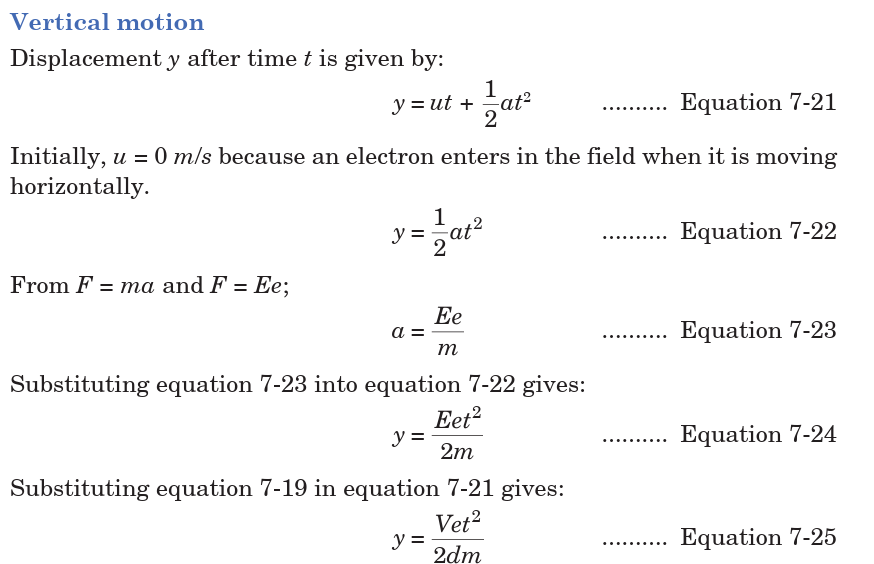



Application Activity 7.2
1. Fig. 7.17 shows two metal plates 2.0 cm long placed 5 mm apart.
A fluorescent screen is placed 20.0 cm from one of the plates. An
electron of kinetic energy 3.2 × 10–6 J is incident mid-way between
the plates. Calculate the voltage applied across the plates to deflect
the electron 2.1 cm on the screen. Assume that the electron movesthrough vacuum.
2. In the diagram of Fig. 7.18, P and Q are parallel metal plates each
of length l = 4 cm. A p.d of 12V is applied between P and Q. The
space between P and Q is virtual. A beam of electrons of speed 1.0
× 106 m/s is directed mid-way between P and Q at right angles to
the electric field between P and Q. Show that the electron beam
emerges from the space between P and Q at an angle of 64.6° to theinitial direction of the beam.
7.3 GRAVITATIONAL ENERGY
7.3.1 Newton’s Law of Universal Gravitation
In 1687 Newton published his work on the law of gravity in his treatise
Mathematical Principles of Natural Philosophy. Newton’s law of universal
gravitation states that
Every particle in the Universe attracts every other particle with a force
that is directly proportional to the product of their masses and inversely
proportional to the square of the distance between them.
If the particles have masses m1 and m2 and are separated by a distance r,
(Fig.7.24) the magnitude of this gravitational force is
The form of the force law given by Equation 7.43 is often referred to as an
inverse square law because the magnitude of the force varies as the inversesquare of the separation of the particles.1
The magnitude of the force exerted by the Earth on a particle of mass m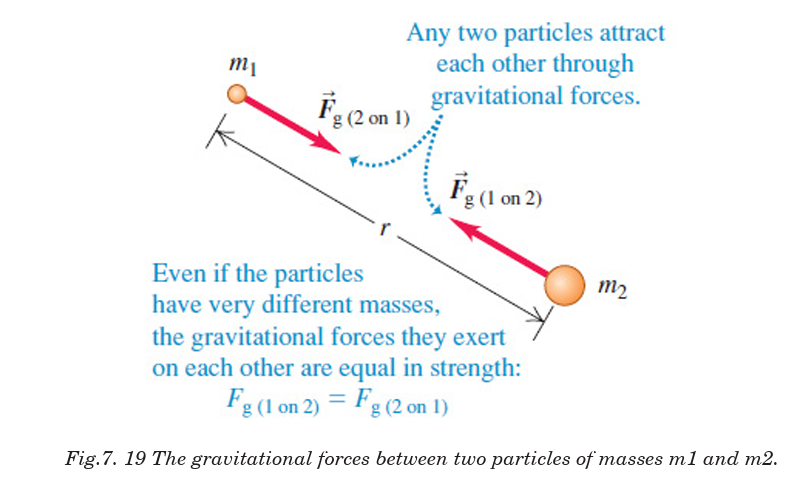
near the Earth’s surface is

This force is directed toward the center of the Earth.
7.3.2 Gravitational potential energy
Gravity is a conservative force, and we may define a potential energy
associate with it. Recall that the work you must do to lift a mass m from
one point to another is equal to the gain in potential energy. Work is doneagainst gravity only when the displacement is radial. Going sideways to r
The work done by the gravitational force when the body moves directly
away from or toward the center of the earth is given by:

We define the corresponding gravitational potential energy U so that
This approximation is useful near the surface of the earth.
If the potential at infinity is taken as zero by convention, the negative signindicates that the potential at infinity (zero) is higher than the potential
The gravitational potential energy of a body of mass m due to the Earth’s
gravitational field is zero at infinity; when a body moves from infinity to a
point in the gravitational field, its potential energy decreases and kinetic
energy increases as shown in Fig.7.32b. Although Equation 7.42 was derivedfor the particle–Earth system, it can be applied to any two particles. That
is, the gravitational potential energy associated with any pair of particles
of masses m1 and m2 separated by a distance r is
When two particles are at rest and separated by a distance r, an external
agent has to supply energy at least equal to in order to
in order to
separate the particles to an infinite distance.
It is therefore convenient to think of the absolute value of the potential
energy as the binding energy of the system. If the external agent supplies
energy greater than the binding energy, the excess energy of the system
will be in the form of kinetic energy when the particles are at an infiniteseparation.
Example 7.7: Binding energy
1. Calculate the binding energy of the earth-sun system neglecting the
effect of the presence of other planets and satellites. Mass of earth = 6 × 10 24,
mass of sun = 3.3 ×10 5 times the mass of earth and the distance betweenearth and sun = 1.5 × 10 8 km.
Answer:The binding energy is the absolute value of the potential energy
We can extend this concept to three or more particles. In this case, the total
potential energy of the system is the sum over all pairs of particles.
of the system is the sum over all pairs of particles.
Each pair contributes a term of the form given by Equation 7.36. For
example, if the system contains three particles, as in Fig.7.29, we find thatby superposition principle.
The absolute value of
 represents the work needed to separate the
represents the work needed to separate the
particles by an infinite distance.
Example 7.8: Superposition of gravitational potential energy
1. A system consists of three particles, each of mass 5.00 g, located at
the corners of an equilateral triangle with sides of 30.0 cm. (a) Calculate
the potential energy of the system. (b) If the particles are releasedsimultaneously, where will they collide?
Answer
The gravitational potential energy of the system is the sum of the gravitational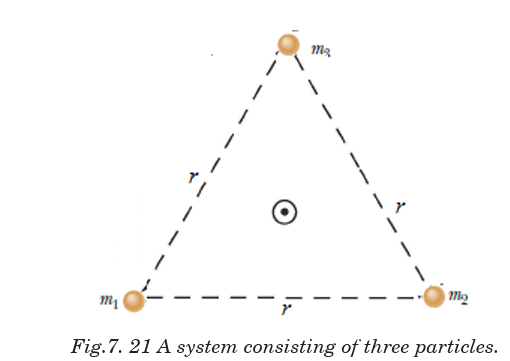
potential energies of all three pairs of particles

The total mechanical energy in a circular orbit is negative and equal to one
half the potential energy. Increasing the orbit radius r means increasing
the mechanical energy (that is, making E less negative). Fig.7.35 shows
the variation of K, U, and E with r for a satellite moving in a circular orbit
about a massive central body. Note that as r is increased, the kinetic energy(and thus also the orbital speed) decreases.
If the satellite is in a relatively low orbit that encounters the outer fringes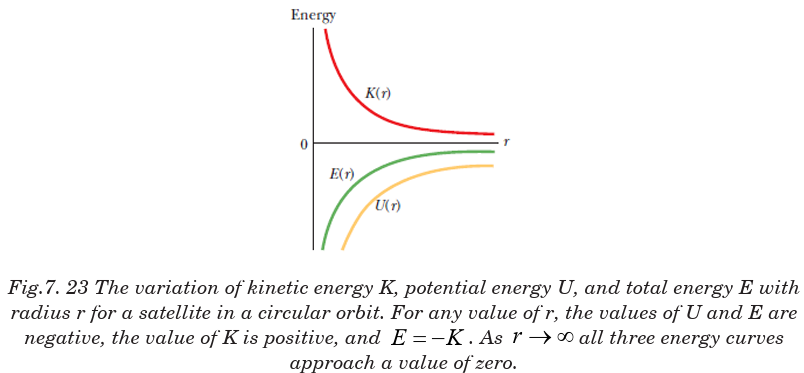
of earth’s atmosphere, mechanical energy decreases due to negative work
done by the force of air resistance; as a result, the orbit radius decreasesuntil the satellite hits the ground or burns up in the atmosphere.
Example 7.9
1. A satellite of mass 450 kg orbits the Earth in a circular orbit at 6.83 Mm
above the Earth’s surface. Find: (a) the potential energy (b) the kinetic
energy and (c) the total energy of the satellite
Answer(a) the distance between the satellite and the center of the Earth is
The total energy equals the negative of the kinetic energy.
Escape speed:
Near the surface of the Earth, the force of attraction between the Earth
and some object is constant and equal to which is independent of the
which is independent of the
height of the object above the Earth’s surface. The gravitational field near
the surface of the Earth is said to be uniform.
If we project an object vertically upward with initial speed in uniform
gravitational field, it will rise to a maximum height given by the law ofconservation of mechanical energy:
If we project an object upward with a very large initial speed so that the
object moves a distance comparable to the radius of the Earth, we must
take into account the decrease in the gravitational force on the object tocalculate correctly the maximum height the object attains.
The minimum speed the object must have at the Earth’s surface in order to
escape from the influence of the Earth’s gravitational field is escape speed.
Traveling at this minimum speed, the object continues to move farther andfarther away from the Earth as its speed asymptotically approaches zero.



7.3.5 Relation between electric and gravitational field
There are many similarities between Coulomb’s law and Newton’s law of
universal gravitation:
• Both are inverse square laws that are also proportional to the product
of another quantity; for gravity it is the product of two masses, and for
the electric force it is the product of the two charges.
• The forces act along the line joining the centres of the masses or charges.
• The magnitude of the force is the same as the force that would be
measured if all the mass or charge is concentrated at a point at the
centre of the sphere.
Therefore, distance in both cases is measured from the centres of the
spheres. In both cases we are assuming that r is longer than the radius of
the object. However, the two forces also differ in some important ways:
The electric force can attract or repel, depending on the charges involved,whereas the gravitational force can only attract.
Just as a mass can be attracted gravitationally by more than one body at
once, so a charge can experience electric forces from more than one body
at once. Experiments have shown that the force between two charges can
be determined using Coulomb’s law independently of the other charges
present, and that the net force on a single charge is the vector sum of allthese independently calculated electric forces acting on it.
END OF UNIT ASSESSMENT
1. Four particles of masses m, 2 m, 3 m and 4 m are kept in sequence at the
corners of a square of side a. Find the magnitude of gravitational forceacting on a particle of mass m placed at the centre of the square.
2. Mass M is divided into two parts xM and (1 – x)M. For a given separation,
the value of x for which the gravitational attraction between the two
pieces becomes maximum. Find this maximum value of x.
3. Three identical point masses, each of mass 1 kg lies in the x – y plane at
points (0, 0), (0, 0.2 m) and (0.2 m, 0). Find the net gravitational force onthe mass at the origin.
4. Two positive charges sit in an (x, y)-coordinate system. The first one has
charge q1
= 0.40 µC and sits at (–0.30 m, 0). The second one has charge q2
= 0.30 µC and sits at (0, +0.30 m). Find the electric potential at the origin.
5. (a) Find the electric potential energy of the system of two chargesshown in the Figure 7.26.
(b) Find the electric potential energy of the system if a third charge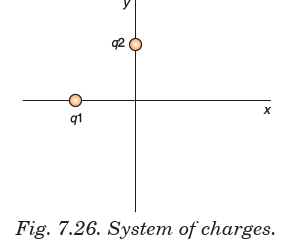
q3 = –0.10 µC is placed at the origin.
6. Two rectangular copper plates are oriented horizontally with one directly
above the other. They are separated by a distance of 25 mm. The plates
are connected to the terminals a 5.0 volt flashlight battery. The positive
plate (the one at the higher electric potential) is at the bottom; thenegative plate (the one at the lower electric potential) is at the top.
If an electron is placed on the upper plate, then released, with what speed
will it strike the lower plate? Use conservation of energy.
7. A charge of +2.82 µC sits in a uniform electric field of 12.0 N/C directed
at an angle of 60° above the +x axis. The charge moves from the origin(point A) to the point (1.40 m, 0) (point B) on the x-axis.
• a. Find the force exerted on the charge by the electric field.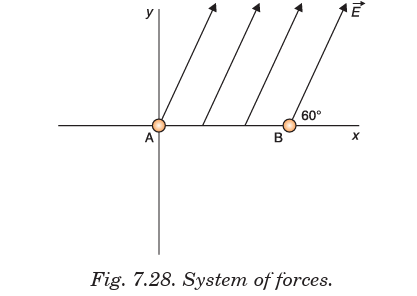
• b. Find the work done on the charge by the electric field as the
charge moves from A to B.
• c. Find the change in the charge’s electric potential energy as it
moves from A and B.• d. Find the electric potential difference between points A and B.
UNIT SUMMARY
Electric Field and Electric Potential Due to a Point Charge
The direction of electric field is taken to be the direction of the force it would exert ona positive test charge.

Electric Potential Energy and Potential Difference
The work done by a conservative force in moving an object between any two
positions is independent of the path taken. Hence, we define the potentialenergy for electrostatic force mathematically as:
Equipotential Lines and Surfaces
An equipotential surface is one on which all points are at the same potential.
An equipotential surface must be perpendicular to the electric field
at any point.
Potential due to Electric Dipole
Unlike electric field lines, which start and end on electric charges,
equipotential lines and surfaces are always continuous closed curved.
Conservation of Electrical Energy
At the instant at which the field is applied, the motionless test charge has
zero kinetic energy, and its electric potential energy is at a maximum. Then,
the charge accelerates, and its kinetic energy (from motion) increases as itspotential energy decreases. The sum of energies is always constant.
Cathode Ray Tube (CRT)
The CRT is a vacuum tube in which a beam of electrons is accelerated and
deflected under the influence of electric or magnetic fields.
These electrons, if left undisturbed, travel in a straight-line path until they
strike the screen of the CRT, which is coated with a material that emits
visible light when bombarded with electrons.
TV and Computer Monitors
In TV and computer monitors, the CRT electron beam sweeps over the
screen in the manner of carefully synchronized voltages applied to the
deflection plates and is called scanning.
Trajectory of a charge moving in a cathode ray tube
The equation of motion of a charge in a field is calculated by consideringvertical and horizontal displacements and is given by:
This equation shows that when electron is in the field, its path is parabolic
and is called the equation of trajectory.
The vertical deflection D of electron on the screen from initial direction ofmotion can be obtained by using equation:
Electrodynamics
When the velocities of the charged particles under consideration become
comparable with the speed of light, corrections involving the theory of
relativity must be made; this branch of the theory is called relativistic
electrodynamics.
Gravitational Potential
The gravitational potential V at a point is defined numerically as work donein taking a uniform mass from infinity to that point.
Escape Velocity for a Planet
If the rocket is fired from the surface of the earth with velocity v such that
it just escapes from the influence of the earth’s gravitational pull. Then thisvelocity is called escape velocity.
Energy Conservation in Gravitational Fields
Conservation of energy tells us that the total energy of the system is
conserved, and in this case, the sum of kinetic and potential energy must
be constant. This means that every change in the kinetic energy of a system
must be accompanied by an equal but opposite change in the potential energy.
